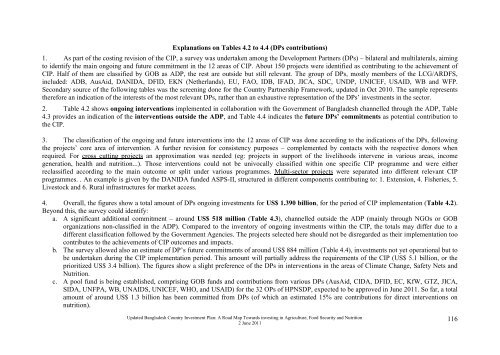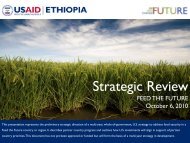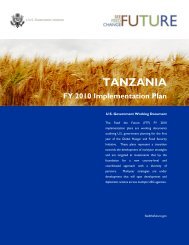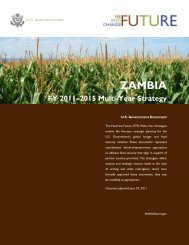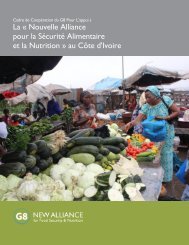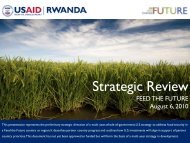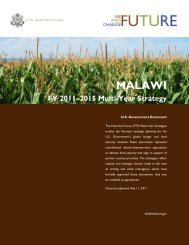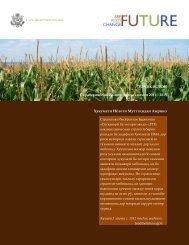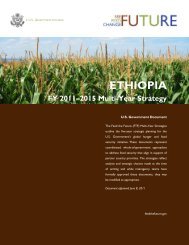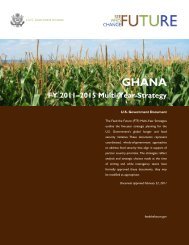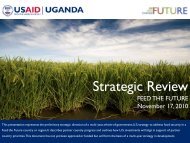Bangladesh Country Investment Plan - Feed the Future
Bangladesh Country Investment Plan - Feed the Future
Bangladesh Country Investment Plan - Feed the Future
You also want an ePaper? Increase the reach of your titles
YUMPU automatically turns print PDFs into web optimized ePapers that Google loves.
Explanations on Tables 4.2 to 4.4 (DPs contributions)<br />
1. As part of <strong>the</strong> costing revision of <strong>the</strong> CIP, a survey was undertaken among <strong>the</strong> Development Partners (DPs) – bilateral and multilaterals, aiming<br />
to identify <strong>the</strong> main ongoing and future commitment in <strong>the</strong> 12 areas of CIP. About 150 projects were identified as contributing to <strong>the</strong> achievement of<br />
CIP. Half of <strong>the</strong>m are classified by GOB as ADP, <strong>the</strong> rest are outside but still relevant. The group of DPs, mostly members of <strong>the</strong> LCG/ARDFS,<br />
included: ADB, AusAid, DANIDA, DFID, EKN (Ne<strong>the</strong>rlands), EU, FAO, IDB, IFAD, JICA, SDC, UNDP, UNICEF, USAID, WB and WFP.<br />
Secondary source of <strong>the</strong> following tables was <strong>the</strong> screening done for <strong>the</strong> <strong>Country</strong> Partnership Framework, updated in Oct 2010. The sample represents<br />
<strong>the</strong>refore an indication of <strong>the</strong> interests of <strong>the</strong> most relevant DPs, ra<strong>the</strong>r than an exhaustive representation of <strong>the</strong> DPs’ investments in <strong>the</strong> sector.<br />
2. Table 4.2 shows ongoing interventions implemented in collaboration with <strong>the</strong> Government of <strong>Bangladesh</strong> channelled through <strong>the</strong> ADP, Table<br />
4.3 provides an indication of <strong>the</strong> interventions outside <strong>the</strong> ADP, and Table 4.4 indicates <strong>the</strong> future DPs’ commitments as potential contribution to<br />
<strong>the</strong> CIP.<br />
3. The classification of <strong>the</strong> ongoing and future interventions into <strong>the</strong> 12 areas of CIP was done according to <strong>the</strong> indications of <strong>the</strong> DPs, following<br />
<strong>the</strong> projects’ core area of intervention. A fur<strong>the</strong>r revision for consistency purposes – complemented by contacts with <strong>the</strong> respective donors when<br />
required. For cross cutting projects an approximation was needed (eg: projects in suppo rt of <strong>the</strong> livelihoods intervene in various areas, income<br />
generation, health and nutrition...). Those interventions could not be univocally classified within one specific CIP programme and were ei<strong>the</strong>r<br />
reclassified according to <strong>the</strong> main outcome or split under various programmes. Multi-sector projects were separated into different relevant CIP<br />
programmes. . An example is given by <strong>the</strong> DANIDA funded ASPS-II, structured in different components contributing to: 1. Extension, 4. Fisheries, 5.<br />
Livestock and 6. Rural infrastructures for market access.<br />
4. Overall, <strong>the</strong> figures show a total amount of DPs ongoing investments for US$ 1.390 billion, for <strong>the</strong> period of CIP implementation (Table 4.2).<br />
Beyond this, <strong>the</strong> survey could identify:<br />
a. A significant additional commitment – around US$ 518 million (Table 4.3), channelled outside <strong>the</strong> ADP (mainly through NGOs or GOB<br />
organizations non-classified in <strong>the</strong> ADP). Compared to <strong>the</strong> inventory of ongoing investments within <strong>the</strong> CIP, <strong>the</strong> totals may differ due to a<br />
different classification followed by <strong>the</strong> Government Agencies. The projects selected here should not be disregarded as <strong>the</strong>ir implementation too<br />
contributes to <strong>the</strong> achievements of CIP outcomes and impacts.<br />
b. The survey allowed also an estimate of DP’s future commitments of around US$ 884 million (Table 4.4), investments not yet operational but to<br />
be undertaken during <strong>the</strong> CIP implementation period. This amount will partially address <strong>the</strong> requirements of <strong>the</strong> CIP (US$ 5.1 billion, or <strong>the</strong><br />
prioritized US$ 3.4 billion). The figures show a slight preference of <strong>the</strong> DPs in interventions in <strong>the</strong> areas of Climate Change, Safety Nets and<br />
Nutrition.<br />
c. A pool fund is being established, comprising GOB funds and contributions from various DPs (AusAid, CIDA, DFID, EC, KfW, GTZ, JICA,<br />
SIDA, UNFPA, WB, UNAIDS, UNICEF, WHO, and USAID) for <strong>the</strong> 32 OPs of HPNSDP, expected to be approved in June 2011. So far, a total<br />
amount of around US$ 1.3 billion has been committed from DPs (of which an estimated 15% are contributions for direct interventions on<br />
nutrition).<br />
Updated <strong>Bangladesh</strong> <strong>Country</strong> <strong>Investment</strong> <strong>Plan</strong>: A Road Map Towards investing in Agriculture, Food Security and Nutrition<br />
2 June 2011<br />
116


